WAITING FOR FIGS
/14 Comments/in Fruit/by Lee Reich(Much of the below information is gleaned from my book Growing Figs in Cold Climates and a video I presented, now available online.)
Affliction
If you’re not growing figs because you think your cold winter climate is wrong for them, you’re wrong and you’re missing out on an exotic treat. Figs can be grown just about everywhere. If you are growing figs and you’re in a cold winter climate, the fruits should be nearly or already ripening.
Impatience is the affliction of the cold climate fig grower. I’m feeling it right now, as I write. That impatience comes from watching little figlets forming and expanding early in the season and then just sitting on the branches, doing nothing, seemingly forever. Knowing something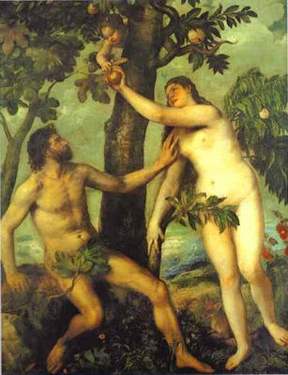 of how fig fruits develop and grow, and ways that ripening can be hastened along helps soothe my affliction.
of how fig fruits develop and grow, and ways that ripening can be hastened along helps soothe my affliction.
Let Me Know Thy Ways (of Fruiting)
Most varieties of figs bear fruit on new, growing shoots. This bearing habit is very different from that of most common fruits, such as apples, peaches, and blueberries, which bear fruit on stems that are one-year-old or older. (Some fig varieties do bear on one-year-old stems, and some bear on both one-year-old and new, growing shoots.) Figs’ bearing habit is a boon to cold climate fig growers because that means that a fig tree can still bear fruit even if its stems freeze back or are pruned back rather severely.
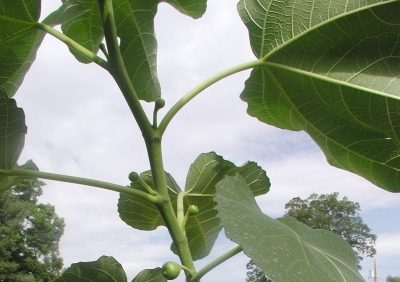
Figs forming on new shoot
But it takes time for fruits on young fig stems to develop and ripen, which they do sequentially from the bottom (the oldest) part of the growing stem to the top. The closer a stem originates to the roots, the longer it takes for fruit on that stem to develop and ripen. That time could be too long, depending on how severely the plant was pruned or froze back and the length of the growing season. I like to develop and leave one or more permanent trunks at least two feet long, letting sprouts grow from or at their tops.
Some so-called “hardy” figs sprout new shoots from ground level after dying back from winter cold. Actually, since ground temperatures in winter are milder than air temperatures, many figs will do this. Problem is that figs will form on those sprouts from ground level but may not have time to ripen.
Quicken the Pace
Assuming a portion of trunk or trunks have survived winter, perhaps because the plant was potted and moved to shelter, the trunk was insulated, or the trunk was buried, etc., impatience still lurks. (I detail a number of ways to get figs through winter in my book Growing Figs in Cold Climates.) The problem — for us, not the figs — is that fruit growth follows a sigmoidal (S-shaped) curve over time. That is, the fruits swell up rapidly early in the season, then just sit for a long time.
But hang tight. If all else is in order, fruit growth leaves the flat part of the curve, and figs start to rapidly swell, at the same time softening and developing a rich, sweet flavor. How long before ripening begins depends on the where the fruiting shoot originated, the variety, and the growing season.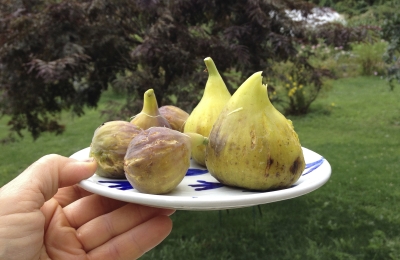
Fortunately, you can hasten along ripening to some degree. The first way is earlier in the season, when a shoot has just a few leaves, say about five. If you pinch out the growing tip, that could stimulate figs down along the stem to start developing sooner than if the stem was left alone. However, doing so also might reduce total yield because shoot growth is at least temporarily stalled.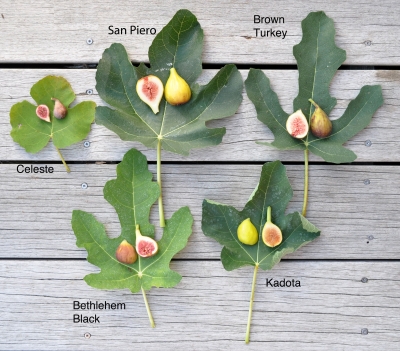
As fruits near ripening, they can be hurried along by “oiling.” Do this by putting a drop of olive oil in the eye of a fruit; I just dip a chopstick in the oil and then let the oil drip off onto the eye.  Very important: Don’t try this on a fruit very far from ripening, which is, of course, hard to tell until the fruit starts ripening. But if you really love your fig tree, you’ve been staring at it a lot. As you do so you’ll begin to notice subtle changes. I’ve typically used this method towards the end of the growing season when fig ripening slows with waning sunlight and cooling temperatures.
Very important: Don’t try this on a fruit very far from ripening, which is, of course, hard to tell until the fruit starts ripening. But if you really love your fig tree, you’ve been staring at it a lot. As you do so you’ll begin to notice subtle changes. I’ve typically used this method towards the end of the growing season when fig ripening slows with waning sunlight and cooling temperatures.
Wait!
Whatever you do, don’t harvest any figs before they are fully ripe. Figs, like many other fruits do not ripen at all once they have been harvested. Incipient rot might make harvested, underripe fruits a bit sweeter, but that’s different from ripe. Commercial figs are harvested just short of full ripeness because then they can be shipped without damage.
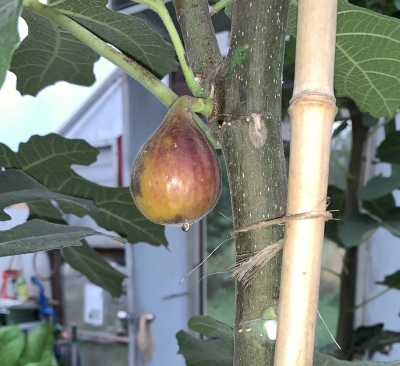
When your fig is fully ripe, the fruit is soft and perhaps has a “tear” in its eye. The flavor will be sweet and rich.
LUSCIOUS LANDSCAPING
/3 Comments/in Fruit/by Lee ReichFrom Alaska & the White Mountains to my Garden
Lingonberry a plant of harsh, cold climates. I’ve seen the plants poking out of rocky crevices in Alaska and high in New Hampshire’s White Mountains, all of which makes all the more surprising the stellar performance of my plants in this hot summer. For years they sat quietly, growing slowly and slowly spreading; this summer, the plants took off, their underground stems reaching further than usual and aboveground stems sporting a very respectable crop. Or, I should say, crops, plural; more on that later.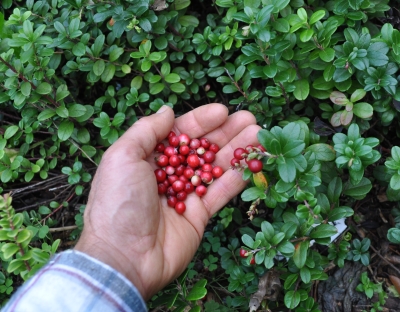
Here in the U.S., lingonberries are little known and, when they are known, it’s as jars of jam. But merely utter the word “lingonberry” to someone Scandinavian and watch for a smile on their lips and a dreamy look in their eyes. Each year, thousands of tons of lingonberries are harvested from the wild throughout Scandinavia, destined for sauce, juice, jam, wine, and baked goods. A fair number of these berries are, of course, just popped posthaste into appreciative mouths.
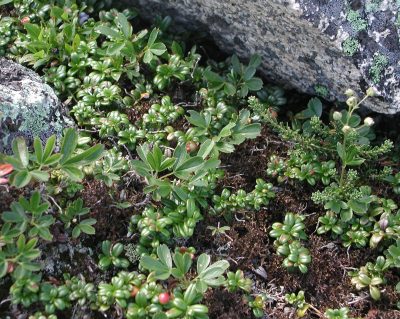
Lingonberry in White Mountains
Lingonberries have often been compared to their close relative, our Thanksgiving cranberries. But lingonberry fruits meld just enough sweetness with a rich, unique aroma so that the fruits — if picked dead ripe — are delicious plucked right off the plants into your mouth or mixed with, say, your morning cereal. As far as I’m concerned, cranberries are never palatable until doctored up with plenty of sugar and heat.
More Than Just Good Looks
As tasty as lingonberry is, I don’t grow it only for its fruit. Lingonberry also outshines its stateside relative in looks. The plants are pretty enough to have garnered a rating of 3, the highest possible, in my book Landscaping with Fruit.
Like cranberry, lingonberry grows only a few inches high and spreads horizontally to blanket the ground with evergreen leaves the size of mouse ears. While the onset of cold weather in fall turns Thanksgiving cranberry’s evergreen leaves muddy purple color, lingonberry leaves retain their glossy, green appearance, like holly’s, right through winter. 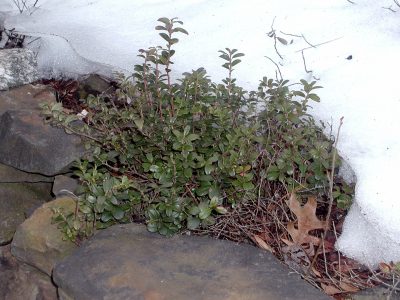 Lingonberry could stand in well for low-growing boxwood — in a parterre, for example, a use first suggested in 1651 by André Mollet, the French gardener to Queen Christina of Sweden
Lingonberry could stand in well for low-growing boxwood — in a parterre, for example, a use first suggested in 1651 by André Mollet, the French gardener to Queen Christina of Sweden
Cute, urn-shaped blossoms dangle singly or in clusters near the ends of lingonberry’s thin, semi-woody stems. These urns hang upside down (upside down for an urn, that is) and are white, blushed with pink. They’re not the kind of blossoms that are going to stop street traffic, but are best appreciated where plants can be looked at frequently and up close — such as in the beds along the path to the front of my house.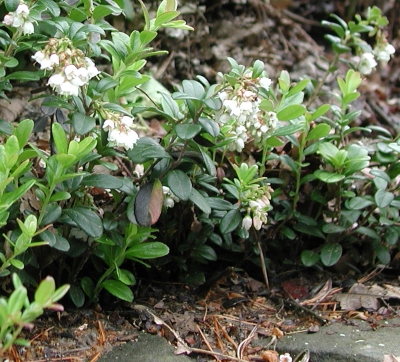
If you miss the spring floral show, you get another chance because lingonberries blossom twice each season. That second show has now morphed into clusters of developing fruits that hang right next to clusters of fruits ripening from the first round of blossoms. Fruit yields are greater from the second flowering than from the first.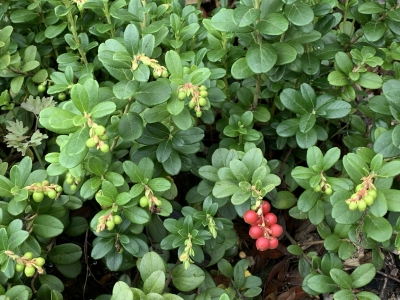
The pea-sized fruits a show in themselves, the bright red berries hanging on the plants for a long time, well into winter. Backed by the shiny, green leaves, they making a perfect Christmas season decoration in situ.
Soil Prep & Management: Obligatory but Easy
Lingonberry plants do need some special care. Hot summer temperatures aren’t ideal. My plants were originally near the east and north sides of my house. Those on the east side are now few and far between, perhaps helped along on the way out by the scratching of the ground beneath them by my chickens, now gone (replaced by ducks, who don’t scratch). The north side of the house, not as welcoming to the chickens because it’s my dogs’ hangout, is, of course, cooler.
All the soils that lingonberries naturally inhabit have good drainage and are extremely rich in humus (decomposed organic material), which clings to moisture. In addition to good drainage and abundant organic matter, lingonberries enjoy the same very acidic conditions — with a pH ideally between 4.5 and 5.5 — required by blueberries, mountain laurel, rhododendron and other kin in the Heath Family. These conditions are easily reproduced in a garden.
I created my bed of lingonberries, which is also home to lingonberry kin, by first checking the soil pH. If the pH is too high, digging elemental sulfur into the top six inches of ground can make it right. Three-quarters of a pound per 100 square feet in sandy soils, or 2 pounds per 100 square feet in heavier soils will lower the pH by one unit. Where soils are naturally very alkaline (pH higher than 8), such as in many parts of the western United States, soil needs to be excavated at the planting site and replaced with a fifty-fifty mix of peat moss and sand. Alternatively, this mix could go into containers plunged into the ground up to their rims. In wet areas, build up mounds of soil and peat, and plant the lingonberries on the mounds, which keeps their shallow roots above water level.
I set my plants at two foot by two foot spacings which plants fill in to form a solid mat over the ground. 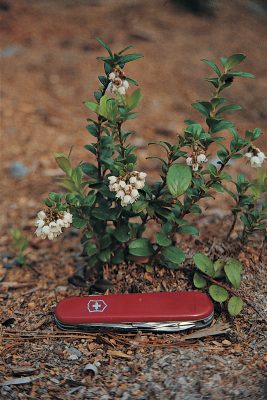 Every year, in late fall, I scatter wood chips, sawdust, or shredded leaves over the plants, enough for an inch or two depth. Sifting down through the leaves and stems to keep the ground cool and moist, to prevent frost from heaving plants in winter, to maintain high humus levels in the soil, to provide some nutrients, and to buffer soil acidity. Every few years I check acidity, and sprinkle sulfur on the soil, as needed.
Every year, in late fall, I scatter wood chips, sawdust, or shredded leaves over the plants, enough for an inch or two depth. Sifting down through the leaves and stems to keep the ground cool and moist, to prevent frost from heaving plants in winter, to maintain high humus levels in the soil, to provide some nutrients, and to buffer soil acidity. Every few years I check acidity, and sprinkle sulfur on the soil, as needed.
Enjoy!
Beyond needing mulching and having their soil acidity monitored, lingonberries are carefree plants. My main “job” is harvesting the berries. No need even to rush picking or eating them. They keep well on or off the bush, in part because they contain benzoic acid, a natural preservative. Refrigerated, the harvested berries keep for at least eight weeks. In nineteenth-century Sweden, lingonberries were kept from one year to the next as “water lingon,” made by merely filling a jar with the berries, then pouring water over them.
My main problem with lingonberries is, at the end of the growing season, deciding whether to harvest and enjoy the berries immediately and enjoy only the glossy, green groundcover or whether to leave the berries on into winter and enjoy the look of the glossy green groundcover livened up with red berries. Or to split the different, occasionally harvesting some of the fresh berries all through winter.

Lingonberry and lowbush blueberry in fall
MY BICOASTAL PLANT
/6 Comments/in Pruning/by Lee ReichA Tree Takes a Plane Ride
I managed to pack lightly for a journey, many years ago, to the West Coast, toting along only an extra pair of pants, a couple of shirts, and a few other essentials. But on the return trip, how could I resist carrying back such bits of California as orange-flavored olive oil and chestnut-fig preserves? The most obvious bit of California that I brought back was a potted bay laurel plant (Lauris nobilis), its single stem poking out of my small backpack and brushing fragrant leaves against the faces of my fellow travelers.
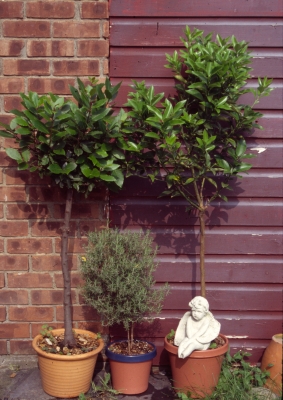
Bay, with its subtropical pals, rosemary and citrus
Not only did the bay laurel bring a bit of California to my home, but also traditions dating back thousands of years from its native home along the Mediterranean coast. Ancient Romans crowned victors with wreaths of laurel and bestowed berried branches upon doctors passing their final examinations. (The word “baccalaureate” comes from bacca laureus, Latin for “laurel berry”.) Bay laurel was sacred to Apollo, so was planted near temples.
Although bay laurel can grow fifty feet tall, my plan was to develop this plant into a small tree with a single, upright trunk capped by a pompom of leaves. The Mediterranean climate is characterized by hot, dry summers, and cool, moist winters. Since the plant is hardy only to about fifteen degrees Fahrenheit, I had to grow it in a pot. The plant is allegedly a rich feeder, but my plants grows fine in my homemade potting mix which contains a healthy portion of compost and — for some extra oomph — some soybean meal.
The potted tree decorates the house in winter, the terrace in summer, and provides fresh bay leaves for soups and other dishes year-round.
A Winter Home
It is in winter that my plant realizes just how far it is from its Mediterranean home. Winters in its home lands are typically cool and moist. Winters inside a northern home are typically warm and dry. Since cool rooms are moister than warm rooms in winter, the cooler the room the better, preferably below fifty degrees. My bay laurel has wintered well either in sunny window in a cool room or near a bright window in my basement, where temperatures are very cool. The warmer the temperatures, the more light bay laurel needs.
The other challenge to my bay tree has been scale insects. They sit along leaves and stems under their protective shell as they suck sap from the plant.  Actually, it’s more of a challenge to me because the plant tolerates scale reasonably well. Once moved outdoors in spring, the plant soon recovers from the attack and its resident scale population, either from the changed environment or from predators, subsides.
Actually, it’s more of a challenge to me because the plant tolerates scale reasonably well. Once moved outdoors in spring, the plant soon recovers from the attack and its resident scale population, either from the changed environment or from predators, subsides.
The problem for me is that the insects exude a sticky honeydew that drips onto furniture and the floor. A sooty black fungus then feeds on the honeydew.
This summer I’ve taken a more active role in thwarting scale by spraying the plant weekly with horticultural oil, which is nontoxic to humans and soon evaporates.
Lollipops
Bay laurel can be trained to any number of shapes such as a pyramid, cone, or globe, with these shapes beginning at ground level or capping a long or short piece of trunk.
Right from the get go, I chose to grow my tree as a “standard.” “Standard” has many meanings both in and out of horticulture, so let’s first get straight which kind of “standard” we are dealing with: Here, I mean a naturally bushy, small plant trained to have a clear, upright stem capped by a mop of leaves. A miniature tree.  In the world of gardening, people are divided over how they feel about “standards.” Some gardeners love them, others will have nothing to do with them.
In the world of gardening, people are divided over how they feel about “standards.” Some gardeners love them, others will have nothing to do with them.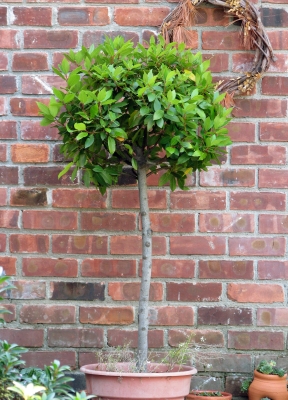
(A “standard” apple tree is one grafted to a rootstock that does not confer any dwarfing.)
For training my lollipop-shaped bay tree, I allowed only a single stem to grow straight upward, and then pinched off any side shoots that developed. When the trunk reached three feet in height, I pinched out the tip to cause branches to form high on the stem. I kept this up, pinching branches and then their branches, to cause further branching, thus forming a dense head. (I devote a whole chapter to standards in my book The Pruning Book.)

Training a standard (rosemary, in this case)
Or, in an illustration (from The Pruning Book):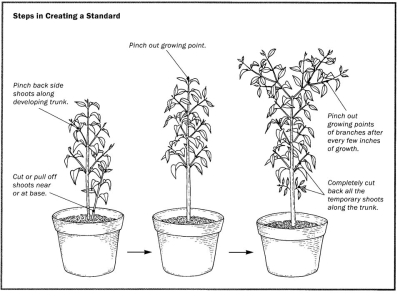
Ongoing care of the tree entails pruning and pinching to keep the mop head to size, and root pruning and repotting the plant every couple of years or so. The time to do any trimming to keep a plant in shape is mostly just as soon as the new shoots mature and stop growing in early summer.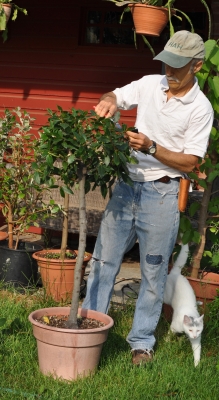
A few years ago, I decided that my tree was too tall and unwieldy; I wanted a shorter standard. Easy: I just lopped the whole plant to the ground and started again. With an established root system fueling new growth, I was able to develop the new lollipop quickly.
All this pinching and pruning yields fresh bay leaves, which find their way into the kitchen. The fresh leaf has a strong flavor, and one cookbook suggests (and I now confirm this) using one leaf for a dish to serve four people. The aroma of the fresh leaf is more than just strong; it actually has a different quality than that of the dried leaf. The fresh aroma is almost oily, to me somewhat reminiscent of olive oil — how California-ish!

